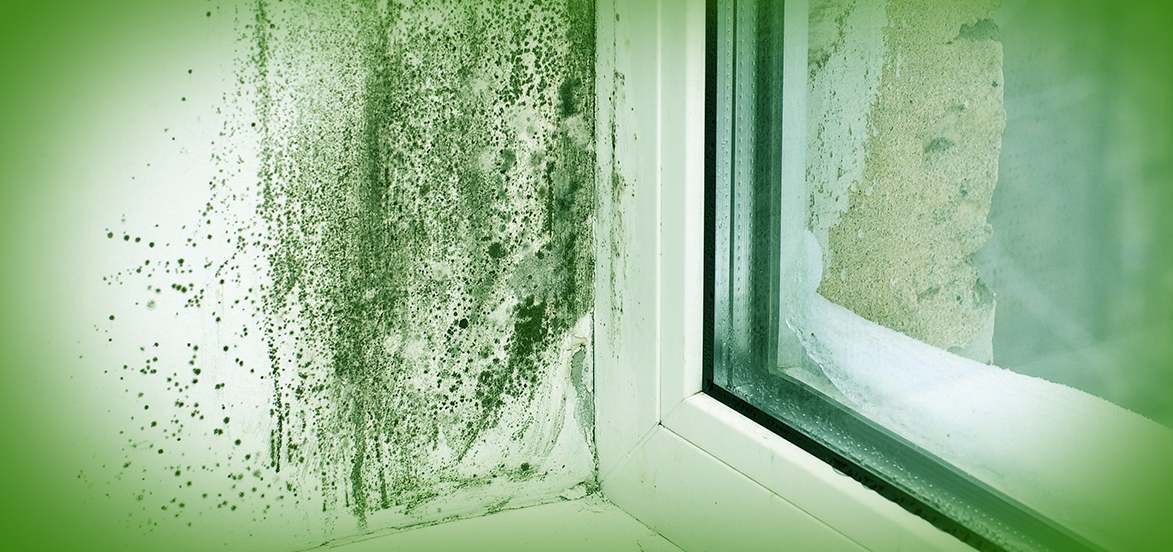How to Get Rid of Mold in Your House?
Mold on the walls of anyone's property is a potentially dangerous problem and is extremely frustrating to get rid of them. It necessitates action as soon as one notices it. Not only does it smell spoiled and look hideous, but it can also damage people's homes and create health problems. But if one has made their mind ready to eradicate it, they first require to know the sign of mildew and mold on walls.
Mold Inspection To Locate Signs Of Mold On Walls:
Mold can grow at any place along an interior wall. But these are most likely to be seen near the floor or ceiling or along the edges of the baseboard trim. It's most common in bathrooms, although it can also affect laundry rooms, basements, kitchens, and other inadequately ventilated rooms. Obvious signs that a person has a mold problem in their home include:
- A damp and musty smell.
- Peeling and cracked paint.
- Noticeable mold growth on their ceiling or walls.
- Allergy signs worsened by staying indoors.
If a person notices mold growth on the walls within their home — even if it's only a miniature patch — they should take a step immediately. If the individual doesn't remove the mold immediately, it will increase and spread all over, and it can become potentially dangerous to their health and their property. Studies have confirmed that exposure to mold can produce poor health and allergic reactions. One may experience symptoms such as irritated eyes, breathing difficulties, and even a running nose. Therefore, it's crucial to call professionals for mold inspection as soon as one notices any indications of mold.
Mold Remediation: How To Get Rid Of Mold On Walls?
Mold on walls is ordinarily easy to get rid of as long as it only covers a small area. One can utilize various products existing in a household. Popular, effective options include baking soda, tea tree oil, bleach, hydrogen peroxide, borax, and vinegar. However, if one has widespread and severe mold growth on their walls, then it's not going to be quite an easy job. It's potentially hazardous to people who wish to remove it themself. It is always advised to people to contact amold removal service provider or professional to get rid of mold in their home effectively and safely.
Things To Keep In Mind During Mold Remediation
One can tackle the job themself if the affected area covers less than 10 square feet as suggested by the Environmental Protection Authority. The mold removal process from walls primarily needs two essential steps. First, one will require to control moisture in their home, and then they will require to kill the mold and stop the growth.
Identify The Cause Of The Mold:
This is the first and most crucial step in the process of getting cleared of mold on walls. One requires to recognize the cause and address the concern to ensure that mold does not return. This indicates repairing any sources of water damage (such as leaks), which have created the mold and regulating moisture in their property.
Prepare The Room and Clean the Walls:
Once an individual is ready to start removing the mold from the walls, clear the area. Ensure that any fabrics, electrical equipment, and furniture from the affected area are removed. Then, for protection, cover the floor with plastic sheets. Next, utilize a damp sponge with dishwashing liquid to clean the affected area and eliminate all the dirt. Our recommendation is before one initiates treating or cleaning the wall with any product, they must put on protective gear like rubber gloves and a mask that will protect the person from exposure to the mold. Also, wear safety glasses for protection. One should also ensure that they open doors and windows while they are removing the mold.
Remove The Mold
If an individual notices small patches of mold painted in the interior of their walls, it's likely to stay on the surface. However, this should be comparatively easy to remove utilizing household products. Options comprise substances such as baking soda, tea tree oil, borax, or white vinegar. Do the mold patches only reach a confined area of a non-porous (sealed or painted) wall? Then our recommendation will be to try a natural mold remover first. In case of a large area of mold growth, you might want to use a stronger chemical cleaner. One can purchase such a cleaner online or from a home enhancement store. On porous walls constructed of materials such as concrete or stone cement, the mold does not only build on the surface. It also manages to spread inside too. So if one has a mold problem on a porous (unsealed) wall, the most practical solution is a combination of distilled white vinegar and hydrogen peroxide.
1. By Using Borax:
In a container, mix one gallon of hot water with one cup of borax. Put the container's lid on, and shake the mixture well to dissolve the borax in the liquid. Take a spray bottle and pour the solution into it and then apply to the concerned area. With the help of a brush, scrub the mold off the wall and then wipe, clean, and leave it to dry. It's not essential to rinse off the solution. The borax will serve to prevent the mold from returning. By applying it, you can fix the source of the issue of mold.
2. By Using Tea Tree Oil:
Tea tree essential oil has antibacterial and antifungal properties delivering it a highly useful treatment for getting rid of mold. Start by adding close to two cups of water and one teaspoon of tea tree oil into a spray bottle. Spray the mixture onto the concerned area and utilize a clean cloth to wipe off the mold. One doesn't require rinsing, as leaving the tea tree oil on the surface of the wall will kill the mold and restrict it from returning. This method is recommended for removing mildew and mold on wallpapered and painted walls.
3. By Using Grapefruit Seed Extract:
Another very effective natural mold killer is grapefruit seed extract. The citric acid released from the grapefruit attacks mold present on the wall and kills it naturally. It also acts as a deodorizer and disinfectant. Generate a solution in a spray bottle adopting a ratio of 10 drops of extract of grapefruit seed to one cup of water. Shake the bottle solution to mix thoroughly and then spray it onto the troubled area. After a few minutes, utilize a clean cloth to wipe off the mold and solution. Leaving the grapefruit seed extract in association with the mold longer will kill them and assure that mold growth does not regenerate. One may require to repeat this process every two to three days to block it from growing back.
4. By Using Bleach:
Bleach is efficient at killing mold on non-porous walls. It will not kill and penetrate roots on porous surfaces. But before one begins cleaning, make sure to test some of the solutions of the bleach on an unnoticeable part of the wall. This guarantees that it will not degrade the finish. One requires to mix three parts of water with one part bleach and then apply the solution to the wall. Leave the mixture on the mold for 10 minutes, then scrub off the mold using a brush. With clean water, rinse the area and dry it with a clean cloth. [Warning]: When using bleach, ensure one opens the doors and windows and wears a safety mask. Bleach creates harsh toxic fumes that can be just as hazardous to inhale as the mold itself.
Types Of Wall
The best technique used for mold removal may vary slightly depending on the type of wall one has: Drywall: Mold prefers to grow on the drywall as it's porous, and what one can perceive is only the top layer. Always try to avoid using bleach — one can try a solution of vinegar. If the mold returns, it's extremely deep in the layers, and the only solution is to replace the drywall. Luckily, mold-resistant drywall is now available in the market. Concrete: Concrete or brick is porous too. So the best solutions are hydrogen peroxide or vinegar as they will remove the mold at the roots. Utilize a brush to scrub and ensure one is reaching close to all of the molds. Cinder Blocks: One would need to clean the wall first for cinder block walls. Then apply their chosen solution and scrub with the help of a brush. Wipe away any residue of mold, apply some more extra solution, and let it sit for up to 20 minutes. Finally, ensure that the wall has dried completely to forestall mold from returning. Wallpaper: For mold on the wallpaper, the best solutions are tea tree oil, vinegar, or grapefruit seed extract. Dip a sponge in the solution, and wring it out to avoid damaging the wallpaper. Don't neglect to test in an unobtrusive area first! Then to remove the mold, gently rub in circles without soaking the wallpaper.
Hiring A Mold Removal Expert
The EPA recommends that if one has significant mold on the walls of their home, they should hire an expert or professional to remove it. However, they state that the individual must ensure the service provider is certified, trained, and insured specifically in mold remediation. Mold removal services and professionals will follow a procedure for remediation. Typically, they'll commence by recognizing the mold by collecting samples and examining it. They will then assess the extent of the individual's issue and create a program to remove mold from the person's property altogether. Finally, they will carry out inspections and publish a clearance report.
Tips For Preventing Mold On Walls
The most efficient way to prevent mold from growing on anybody's walls is to control moisture in their property. One can minimize the humidity within their home by ensuring all rooms are well ventilated and using a dehumidifier. Condensation can also create mold in their home. However, one can help to prevent it by insulating windows, exterior walls, pipes, and roofs. Kitchens and bathrooms are particularly prone to mold. Assure that these rooms are regularly cleaned in order to prevent spores from growing.
Clean Home, Clean Walls:
If one notices signs of mold growth on the walls of their home, they will need to take action where it spreads. Mold has the potential to produce health issues and structural problems to an individual's property. Fix the source of the problem as it is the most important thing to do to prevent mold growth. Then, depending on the size of the affected area, one can either clean the mold themself or hire our mold removal services. Removing miniature patches of mold themself is fairly easy. One can utilize products that are readily available such as borax, tea tree oil, bleach, hydrogen peroxide, vinegar, and baking soda. But, one should definitely seek the help of an expert immediately if mold covers a substantial area of a wall. If you need mold removal services, contact us anytime, anyday!


